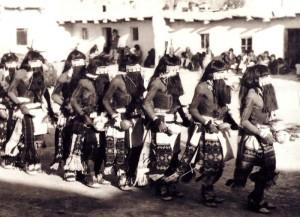As an historical and methodological matter, science owes a great deal to supernaturalism. This indebtedness, or what we might call a close structural relationship, becomes evident when we consider the history of the invisible. Postulating the existence of invisible entities or forces that influence or govern causation is not just for spiritualists: it also makes for good science. There are of course some fundamental differences in what is postulated and the requirement of testing, but it’s not hard to see how science and the supernatural work similarly in terms of “invisible” theory. Emile Durkheim was perhaps the first to make this point, which was developed brilliantly by Robin Horton.
I was reminded of all this while recently reading an essay by Sam Gill, Professor of Religious Studies (with a focus on Native Americans) at CU-Boulder. This excerpt was particularly arresting:
One approach used to initiate children into their religious lives was to disenchant them out of their child’s point of view. Children were encouraged to accept a naive realism, to hold the view that the world was at it appeared to them. Among the Hopi of the southwestern United States, such an approach is still used. The children are encouraged to view the masked spirit beings, kachinas, as the spirits themselves. The children never see the personators without masks, or masks that are not being worn. It is integral to the initiation that process that the children witness for the first time the masked figures costumed but without their masks. Recognizing the kachinas as their male relatives, they are sorely disenchanted. Many cry and feel that they can never again trust adults.
The long-term effect of this approach to the initiation of the religious life is striking. To truly appreciate the spiritual world, to see the fuller dimensions of reality, they learn that the world is more than it appears to be. The Hopi and other American tribal cultures use a technique of creating a naive view only to destroy it, utilizing the power of disenchantment that accompanies the loss of naïveté to initiate deeper inquiry and insight.
This is fascinating. Disenchantment, in the Weberian sense, is usually associated with increasing secularization and advancing scientism. By this process (which has not unfolded in the way sociologists had earlier predicted), the cosmos comes to be seen as inert and mechanical. Ironically, this “seeing” depends on our ability to measure and manipulate the invisible. In the Hopi or Amerindian case, the disenchanting procedure is simply reversed. In the former case, the destruction of naive realism is in the service of science; in the latter case, it’s in the service of supernaturalism.
This passage also reminded me of the trauma some children suffer when they are told, after years of being lied to by their parents and the larger culture, that Santa Claus is not real. This particular form of disenchantment doesn’t seem to be in the service of anything, except perhaps the sinking realization that “presents” don’t magically appear and they aren’t free. This particular form of disenchantment might be seen as early baptism into commercial life.
Gill’s essay (“Religious Forms and Themes”), by the way, appears in a collection titled America in 1492: The World of the Indian Peoples Before the Arrival of Columbus (1991, ed. Alvin Josephy). Those who have read Charles Mann’s 1491: New Revelations of the Americas Before Columbus will probably enjoy this collection of essays by experts in their respective fields. While Mann’s book has better narrative coherence and flow, the Josephy volume is intellectually beefier and geographically more extensive. The latter also contains a chapter on Amerindian languages in which the author (anthropologist and linguist Joel Sherzer at UT-Austin) discusses the intensely metaphorical nature of those languages. Sherzer’s claims are sure to incense my dear friend and metaphor-meister Dominik.


